Plant Life: Vertical Living vs. Garden Sprawl
Where do you live? Not what town, city or Rural Road, but rather, in a condominium or apartment building? A sprawling ranch house property? Basement rental or a cozy little row home? Or perhaps a mid-town property with average sized yards front and back.
Setting aside for the moment any socio-economic issues, these are some of our options as creatures of choice. Given the opportunity, we can choose where we live. Plants, on the other hand, and particularly those in controlled garden environments, don’t have such options. They’re put in the ground where the gardener wants them to be, and that then is their lot in life.
For the novice gardener, this can present some particular challenges. With much yet to learn, the beginner may not be aware of certain considerations that need to be made on behalf of our plants. Our other blog posts have, or will, talk about things like crop rotation and companion planting, but for this post, let’s explore the physical supports, the infrastructure some plants need – specifically, trellises and stakes.
In short, some edibles need a physical structure to help keep the plant off the ground. If not given that structure, these plants will sprawl along the ground, often in a tangled mess, which could lead to disease, insect infestations, inconsistent growth due to blocked sunlight, wasted garden real estate, spatial conflicts between plants, rotting fruit, and an overall chaotic looking garden.
Climbing plants have all sorts of great benefits, especially for the space-challenged garden. Instead of sprawling across your garden bed, taking up valuable growing space, your climbers move up the trellis – vertical living, if you will.
In terms of garden infrastructure, there are three different types of plants:
- those that need the support of a trellis,
- those that need the support of a stake, and
- those that need no support.
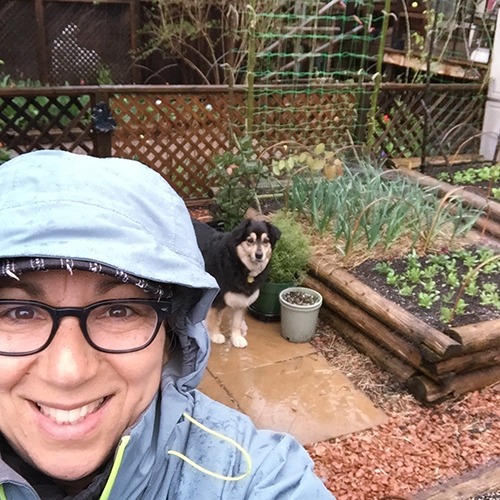
Plants that need no Support
Those that need no support tend to be ground-huggers. Pretty much all herbs can grow independently, without any physical support. That’s not to say that they don’t need tending. Regular watering is essential, a protocol that will be defined by the plant. (Better example or no example, as basil needs staking and this is a “needs nothing” section) No edible plant likes dry conditions, but the light feeding Basil, for instance, prefers damp vs. wet and will want a little less frequent watering. Many herbs also flourish with regular harvesting which encourages renewed growth – kind of like a hair cut.
Another self-supporting plant is the increasingly popular ground cherry, a member of the nightshade, or Solanaceae family of plants. Ground cherries are beautiful plants that produce a plethora of small orange fruits that are wrapped in a paper husk similar to tomatillos, only smaller and more prolific. With a thick, trunk-like stalk and a broad umbrella-like canopy much like a tree, the ground cherry needs no physical support to flourish.
Zucchini and a few other types of squash are plants that require next to nothing in terms of structural support, despite their large, sprawling nature. These guys are happy just growing across the top of the soil, a behaviour that can lead to some issues of their own. For instance, fruit that sits on the damp soil for too long can rot, and give easy access to soil-bound insects. However, a nice thick layer of straw mulch can help eliminate these potential problems.
Some other plants that grow well without physical infrastructure include all sorts of leafy greens (lettuces, Asian greens, spinach, and arugula, amongst others), root veggies such as radishes and beets, as well as garlic and rhubarb.
Plants That need Trellising
There are basically five different growth patterns or devices used by plants that aid in their ability to climb, three of which we will explore here.
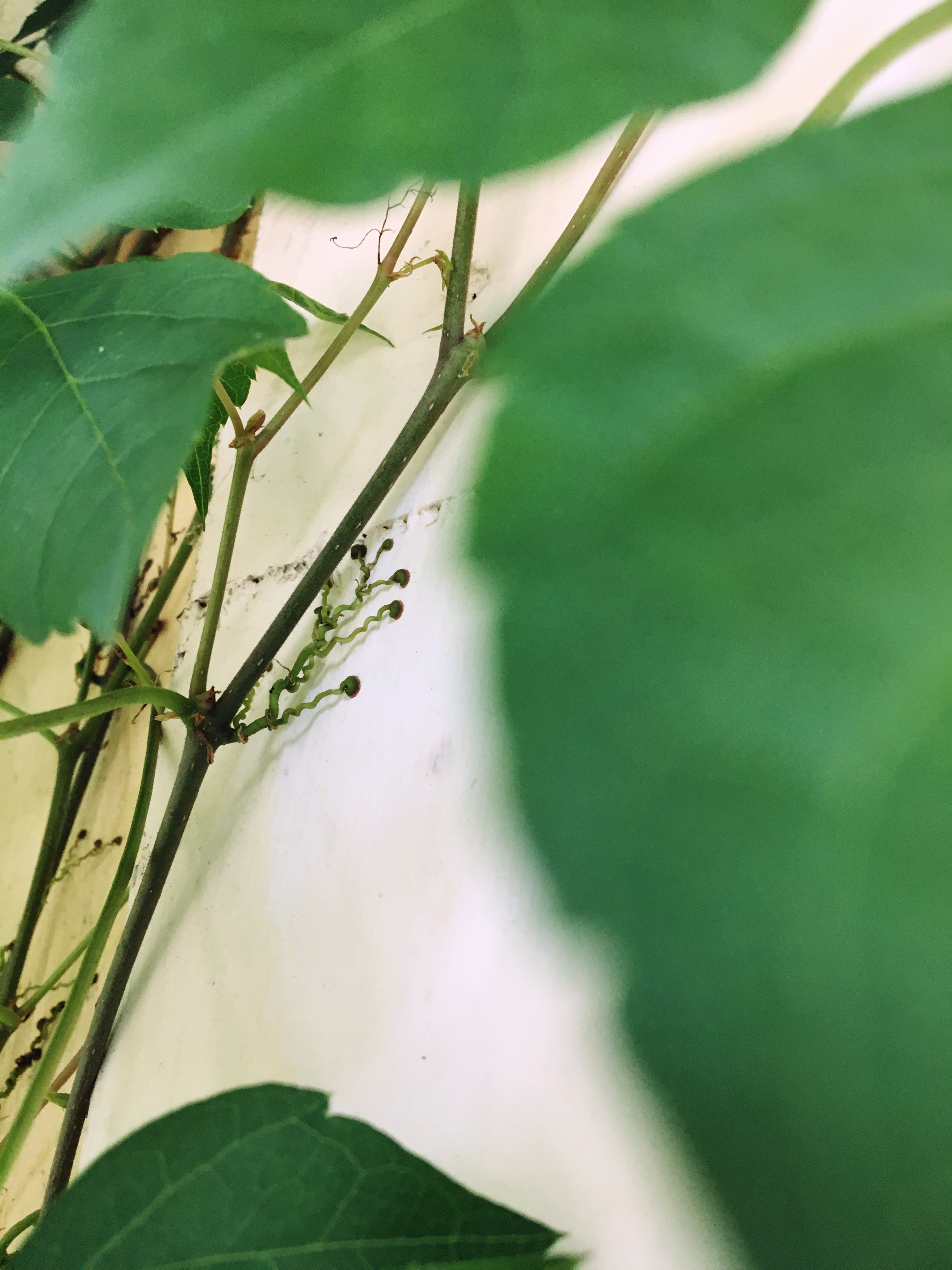 Adhesive pad |
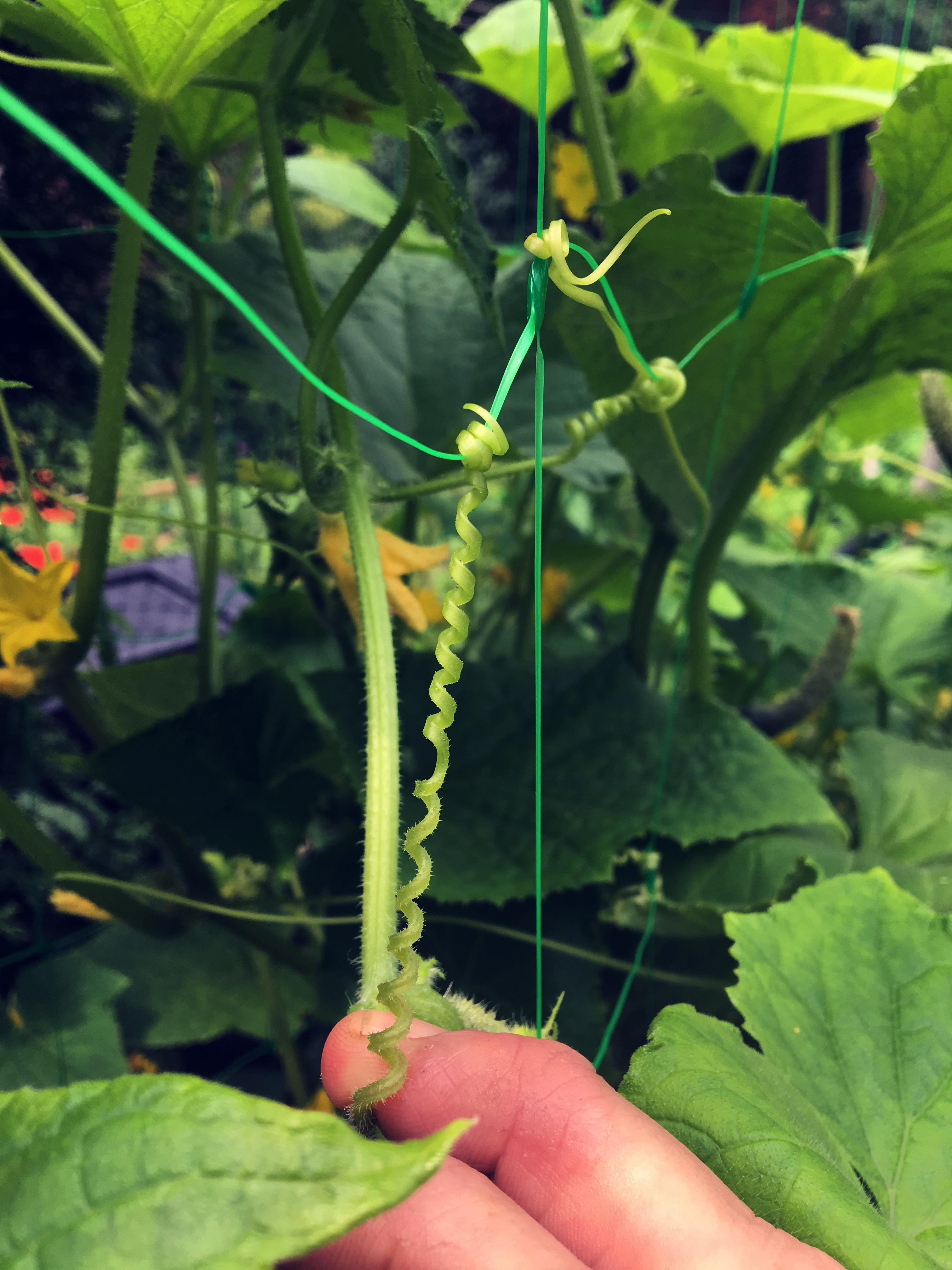 Cucumbers grow tendrils |
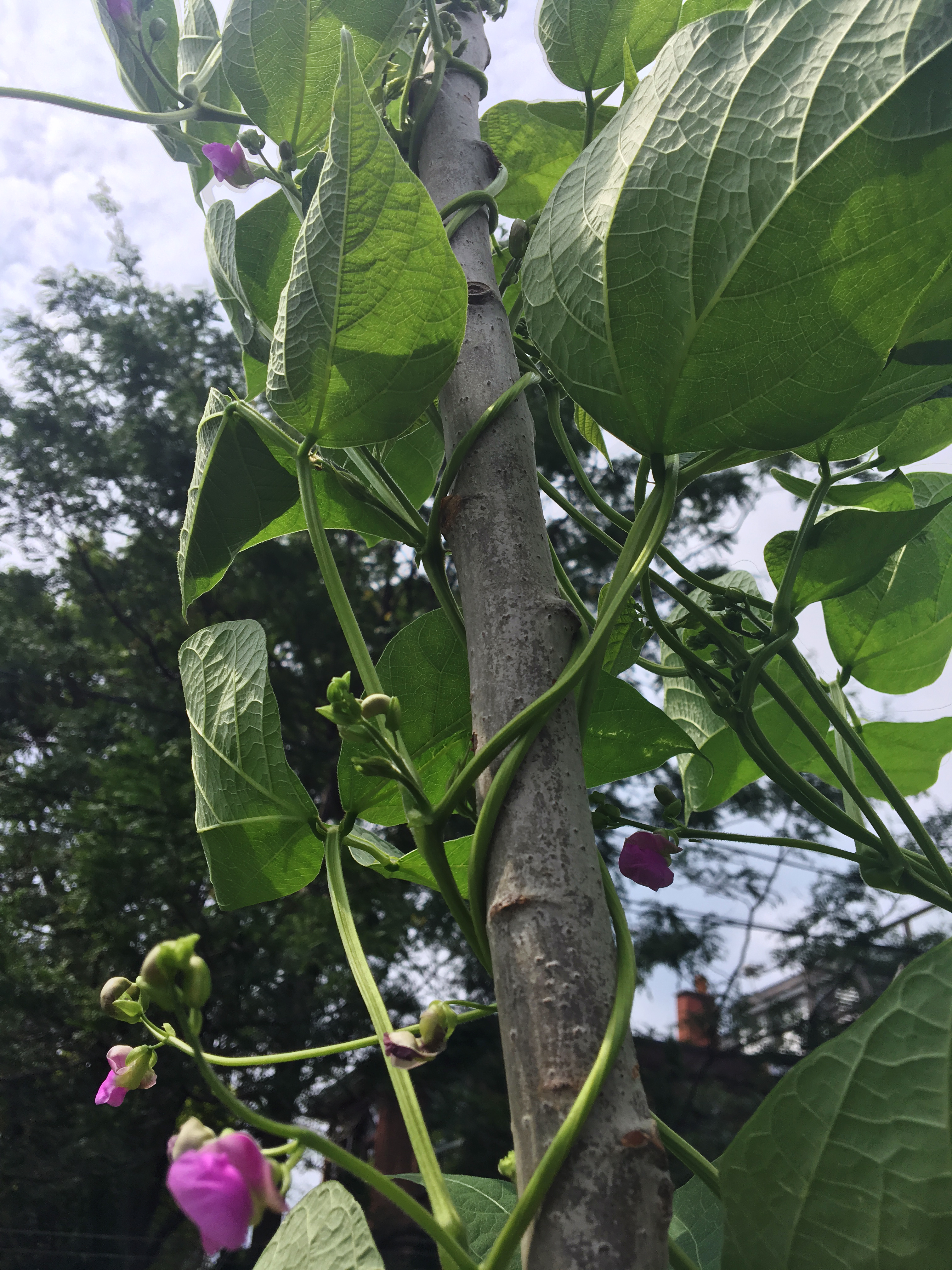 Bean plants twine |
Some climbing plants, more common in the ornamental plant world, use little adhesive pads or discs, and they do exactly what their name suggests. Hundreds of little discs adhere themselves to just about any available structure – brick, vinyl siding, tree bark, rocks – as they climb unencumbered to whatever height their host allows. Boston Ivy and the aggressive growing Virginia Creeper are common examples of adhesive disc climbing plants.
Other climbers utilize fascinating devices known as tendrils. Tendrils are thin, almost wire-like structures that protrude from the plant in search of something to grab on to. Once the tendril touches something, such as a part of the trellis, it will start to curl itself around. It curls and curls, for two main reasons. First, simply to hold on, but there are many more curls in a tendril that, at a glance, seem extraneous. In fact, these extra curls act like little spring-loaded shock absorbers. As the plant gets pushed around by wind and rain, those curls expand and contract in real time, absorbing the energy that is being exerted upon them. If the tendril were only a straight line between the plant and the support, it would just snap in a high wind. Instead, the tendrils expand and contract, allowing the plant to move with the wind with little resistance. Ingenious!
Some of our favorite foods are tendril growers, including cucumbers, peas, and some squash and melons.
A third climbing method is called twining (as in twine). These plants don’t have any specific parts to help them climb – no adhesive cups, no tendrils. They simply wrap themselves around an object and work their way upwards. Pole beans are probably the most common and best-known twiners, but the system is also used by the beautiful Morning Glory and Bougainvillia. (Rumour has it that Morning Glory seeds can be steeped to make a hallucinogenic tea, but we do NOT recommend trying this at home!)
In our new vegetable garden installations, there usually aren’t pre-existing structures in place to support climbing plants, so we add things. Trellises, for example. A trellis is a framework of material used to support plant growth – basically any structure on which plants can climb, including obelisks, pergolas, arbours, maypoles and stakes. They can be as simple or as intricate as you like, as long as they have the strength for the job.
You can purchase pre-fabricated trellises made from cedar or other wood, cast or wrought iron, stainless steel or other metals, bamboo, or task-specific plastic mesh. Chain link fences that abut a garden make fabulous trellises, especially because they’re often already in place. For BUFCO clients, we custom build our trellises using poplar saplings for the frame, hang trellis netting within that frame, and screw the whole thing into our wooden raised beds.
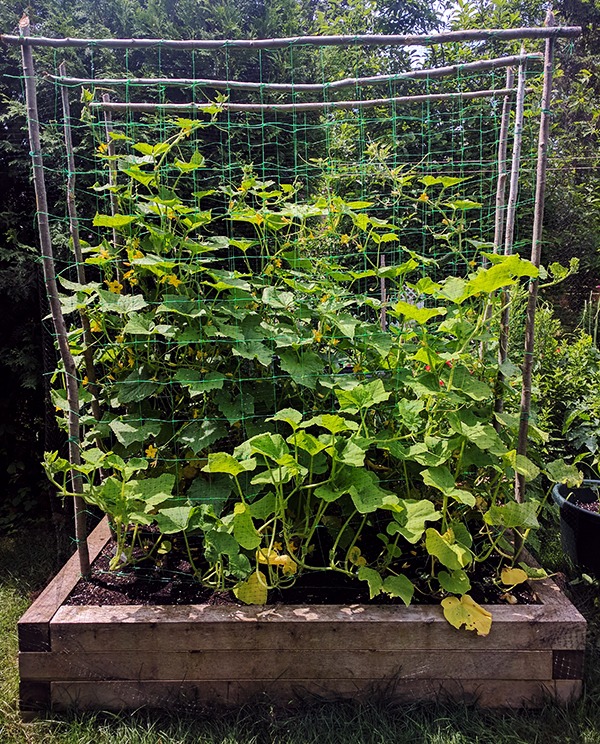 Our cucumber condo |
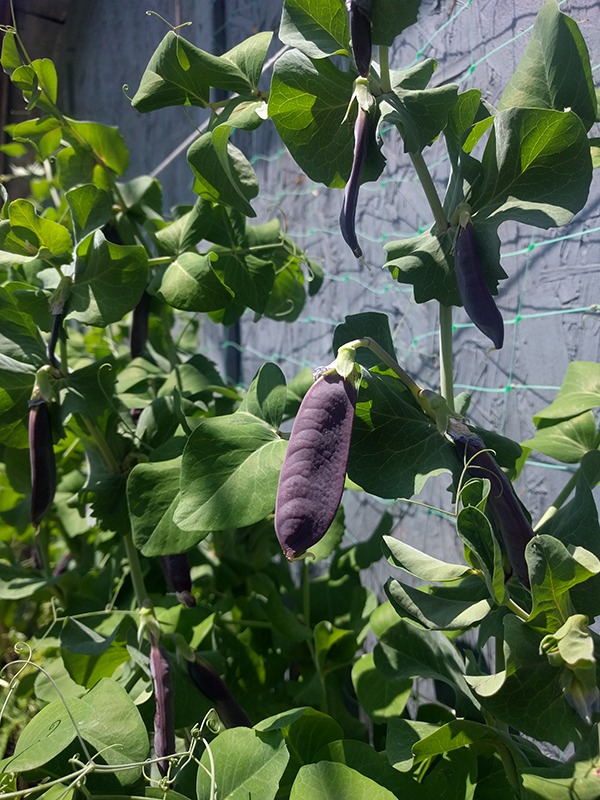 Blue soup peas, hangin’ out |
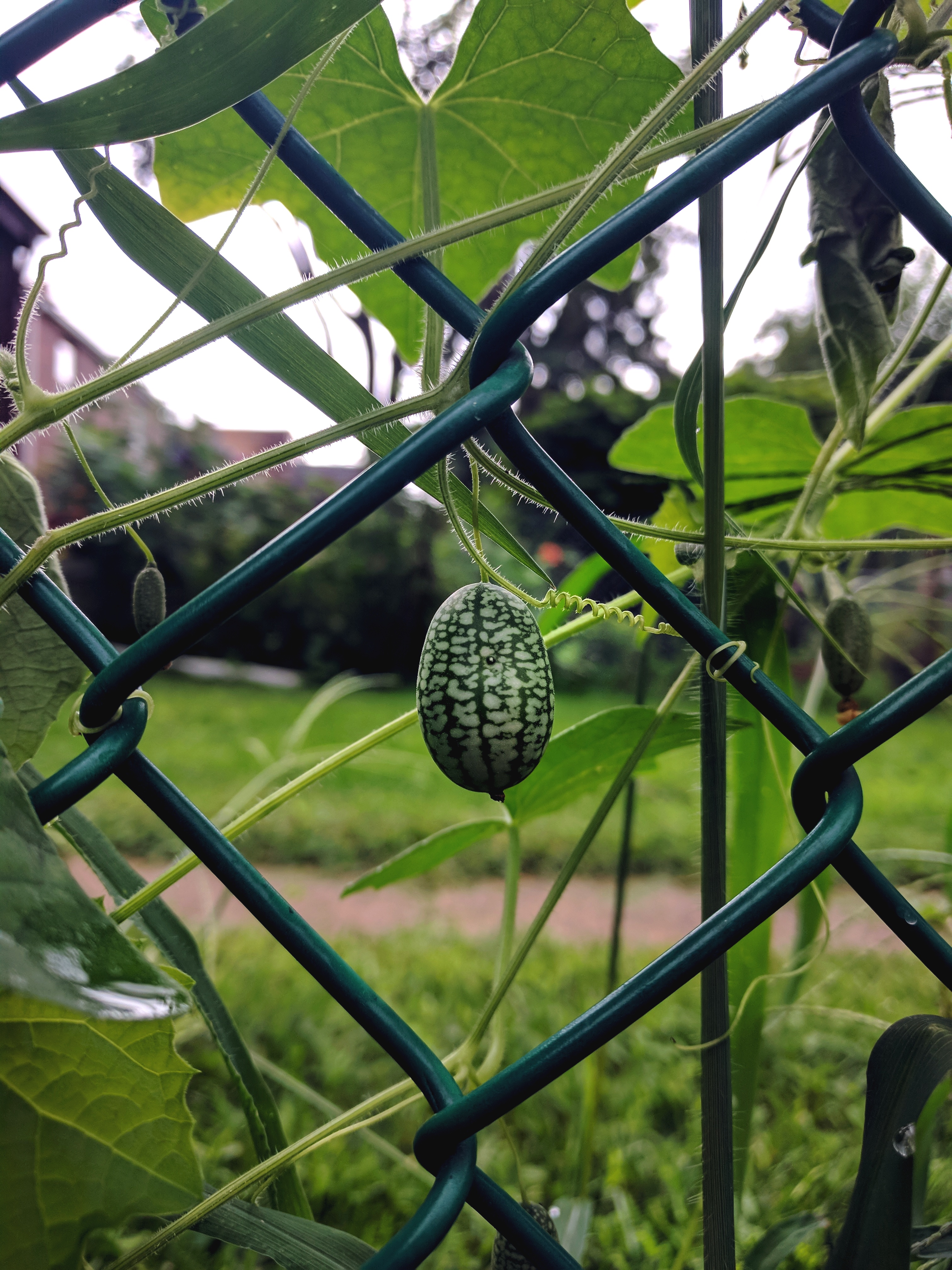 Cucamelons on chain link fence |
Plants that need staking
There is another group of plants that include some of the most popular edibles – tomatoes, sweet and hot peppers, eggplant, tomatillos… These plants will need some support, but they have no built-in mechanism to help them stay vertical and so they rely on the intervening the gardener to intervene. Tomato plants are basically very top-heavy vines that, without support, will keel over and sprawl along the ground in an unhealthy and unsightly mass. Peppers and eggplant will also become top heavy, and as the fruit grows, their single or double stalks will bend and quite possibly break.
A simple stake is a frequently used device used to help these plants along. Stakes are really just single poles, whether bamboo, cut tree saplings, fallen branches, purpose-made tomato spirals (we love these!) or even strings hung from above. There are many pre-fabricated options to be found in stores, but a lot of gardeners use ingenuity and implement found objects to do the job.
Tomato plants will require numerous stakes, one for each fruit-bearing sucker that is left on the plant. Each sucker will need to be attached with string, garden wire, or special tomato clips to the stake. Be careful when attaching the plant to the stake. You don’t want to wrap the plant too tightly, and you’ll want to accommodate future growth as the stem thickens over time.
When would you use a stake instead of a trellis, or a trellis instead of a stake? Stakes are generally better when only a single device is required. A trellis might be too complex and large a device for tomatoes, peppers, eggplant, where single stakes will be easier to work with. Trellises are much better for plants that have rely on adhesive discs, tendrils, or twining for their vertical growth.
 Tomato spirals are for tomato jungles as rebars are for concrete jungles. |
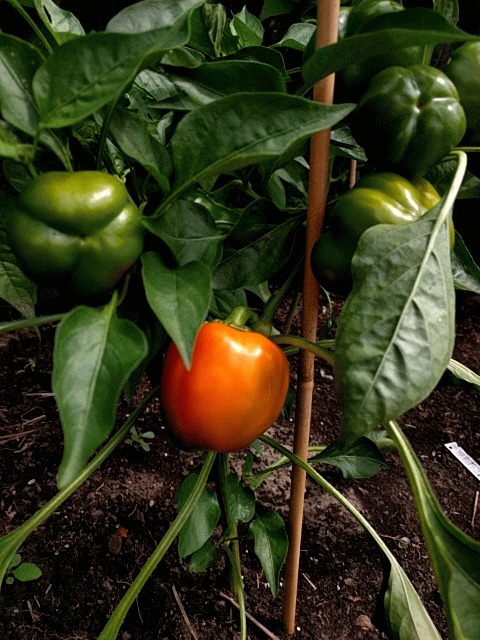 Bamboo stake helping a pepper plant carry its hefty fruit. |
Just like people, some plants need support. Sometimes they even need a little emotional support – a nice, soothing voice, perhaps a little music to grow by – but mostly, they’ll just need a shoulder to lean on while they reach for the sky.